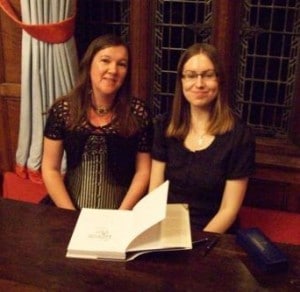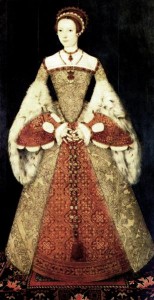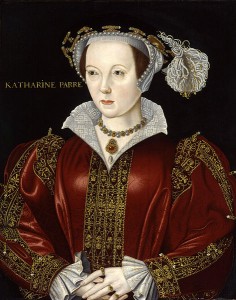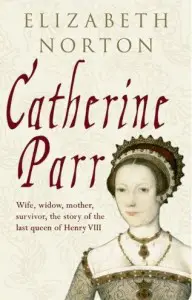
Today, we have a guest post from author and historian Elizabeth Norton who joined us on our recent Anne Boleyn Experience 2010 at Hever Castle. We were all thoroughly impressed with Elizabeth’s talk, her knowledge and her passion for history, and this shows through in her written work too.
Elizabeth has done Anne Boleyn, Jane Seymour and Anne of Cleves a great service in her biographies of them and she has just done the same to Henry VIII’s sixth and final wife, Catherine Parr, in her recent biography “Catherine Parr” – click here to read my review of this excellent book.
In the following article, Elizabeth looks at the plot against Catherine Parr and how it was different to the plots against Anne Boleyn and Catherine Howard – she has an interesting theory.
Catherine Parr in Danger by Elizabeth Norton
The plot against Catherine Parr which occurred in 1546 and nearly led to her arrest on a charge of heresy is well known. Superficially, the circumstances appear self-evident and Henry VIII’s sixth wife came within a whisper of imprisonment in the Tower and, in all likelihood, death. There is no doubt that Catherine perceived herself to be in grave danger, but there is some evidence that matters were not entirely as they seemed and that, far from desiring his last wife’s death, Henry VIII instead intended merely to issue a warning to her.
 The facts of Catherine’s brush with danger were detailed by John Foxe in his Actes and Monuments, compiled after Catherine’s death. Catherine believed that it was God’s will that she become queen and, like Anne Boleyn before her, she was determined to promote her reformist views. Henry was very far from sharing Catherine’s commitment to the religious reform and, whilst he orchestrated the break with Rome and some reform of the church, he remained, for the most part, religiously conservative. Catherine, encouraged by Henry’s silence regarding her promotion of the reform at court, which she took to be tacit approval, took matters a step further. According to Foxe, she began “frankly to debate with the king touching religion, and therein flatly to discover herself; oftentimes wishing, exhorting, and persuading the king, that as he had, to the glory of God, and his eternal fame, begun a good and a godly work in banishing that monstrous idol of Rome, so he would thoroughly perfect and finish the same, cleansing and purging his church of England clean from the dregs thereof, wherein as yet remained great superstition”. After one such exchange, Henry commented to the conservative Stephen Gardiner, Bishop of Winchester, “a good hearing, it is, when women become such clerks; and a thing much to my comfort, to come in mine old days to be taught by my wife”.
The facts of Catherine’s brush with danger were detailed by John Foxe in his Actes and Monuments, compiled after Catherine’s death. Catherine believed that it was God’s will that she become queen and, like Anne Boleyn before her, she was determined to promote her reformist views. Henry was very far from sharing Catherine’s commitment to the religious reform and, whilst he orchestrated the break with Rome and some reform of the church, he remained, for the most part, religiously conservative. Catherine, encouraged by Henry’s silence regarding her promotion of the reform at court, which she took to be tacit approval, took matters a step further. According to Foxe, she began “frankly to debate with the king touching religion, and therein flatly to discover herself; oftentimes wishing, exhorting, and persuading the king, that as he had, to the glory of God, and his eternal fame, begun a good and a godly work in banishing that monstrous idol of Rome, so he would thoroughly perfect and finish the same, cleansing and purging his church of England clean from the dregs thereof, wherein as yet remained great superstition”. After one such exchange, Henry commented to the conservative Stephen Gardiner, Bishop of Winchester, “a good hearing, it is, when women become such clerks; and a thing much to my comfort, to come in mine old days to be taught by my wife”.
Gardiner and his ally, Henry Wriothesley, the Lord Chancellor, distrusted Catherine’s influence at court and, in May 1546, Wriothesley had arrested the outspoken religious reformer, Anne Askew and subjected her to torture. Askew’s interrogators asked her intently about her dealings with “my lady of Suffolk, my lady of Sussex, my lady of Hertford, my lady Denny, and my Lady Fitzwilliams”, all members of Catherine’s inner circle, and it is clear that Wriothesley’s interest in Askew was directed at gathering evidence against Catherine herself. In spite of the break with Rome, many of the fundamental tenets of the religious reform remained illegal, and beliefs held by Catherine, such as a denial of the miracle of the Eucharist, were treasonous. In July 1543, for example, four men with connections to the court were tried for heresy at Windsor, demonstrating the danger that Catherine was in. Gardiner seized the opportunity afforded by Henry’s irritation towards Catherine and he secured the king’s consent to her arrest.
Henry gave no indication to Catherine of what was happening and, whilst preparations for her arrest were made, she continued to debate religion with him. One evening, Henry summoned his physician, Dr Wendy, who had previously been Catherine’s own doctor and was close to her, and informed him of the plot before swearing him to secrecy. Shortly afterwards, a copy of the articles against Catherine was discovered by a member of her household. Catherine became hysterical when she saw the document and, hearing that she was ill, Henry sent Dr Wendy to her, who informed her of what the king had said. Forewarned, Catherine went the next night to the king and found him sitting with a number of gentlemen of his household. When Catherine entered, Henry “began of himself, contrary to his manner before accustomed, to enter into talk of religion, seeming as it were desirous to be resolved by the queen, of certain doubts which he propounded”. Catherine recognised this for the trap that it was and refused to be drawn, insisting that she could never presume to instruct the king on religion and that “yet must I, and will I, refer my judgment in this, and in all other cases, to your majesty’s wisdom, as my only anchor, supreme head and governor here in earth, next under God, to lean unto”. When further pressed, she insisted that she had only previously dared to dispute with the king in order to learn from him and to try to take his mind off his painful leg. With this, Henry was satisfied and informed his wife “that perfect friends we are now again”. He apparently forgot to inform Wriothesley of this reconciliation and when, the following day, the Lord Chancellor arrived with soldiers to arrest the queen in Henry’s presence, the king violently attacked him.
From the facts laid out by Foxe, it appears that Catherine had a lucky escape. However, on closer analysis, it is less clear just how real the danger was. Catherine certainly believed herself to be in danger and, had she not acted decisively, it is likely that Henry would have allowed her to be arrested and, perhaps, executed. The key to an analysis of the plot against Catherine lies in the king’s own behaviour. Previously, when Henry took the decision to rid himself of a wife, he immediately denied the queen access to his person. With Anne Boleyn, for example, Henry abruptly left her at Greenwich to ride to Westminster, ordering Anne’s arrest the following day. With Anne of Cleves, Henry ordered that she be sent to Richmond and only met with her again after his marriage to Catherine Howard. With Catherine Howard, although, for a few days, Henry remained in the same palace as her after her arrest, he refused to grant her any access to him. Catherine Parr, however, was able to continue to visit Henry. By informing Dr Wendy of the plot, who Henry knew was close to Catherine, the king must also have realised that it was likely that she would hear of what was happening. The ‘mislaid’ copy of the articles is also telling and it does appear that Catherine, unlike her predecessors as Henry’s wife, was given every opportunity to save herself.
Further evidence for Henry’s hand in Catherine’s deliverance can be seen in the facts of earlier plots against Catherine’s ally, Thomas Cranmer, Archbishop of Canterbury, and her enemy, Stephen Gardiner. Cranmer’s reformist beliefs were well known during Henry’s reign and, according to the account of his secretary, Ralph Morice, the king personally alerted the archbishop to a plot against him by the gentlemen of Kent, showing Cranmer a copy of the accusations against him and declaring “Ah, my chaplen, I have newis for you: I knowe nowe who is the greatest heretique in Kente”. Cranmer must have turned white at this, but, as a gesture of his confidence in him, the king appointed the archbishop at the head of a commission to investigate the allegations. The king also protected Cranmer when he was accused in parliament of heretical preaching.
 The third attack against Cranmer is very similar to that against Catherine and was led by members of Henry’s council, which included Gardiner, Wriothesley, and the conservative Duke of Norfolk. They went to the king and informed him that “the archebisshopp being of his privie counsaile, none man durst objecte matter against hym oneles he were firste committed unto indurance, whiche being don, men wolde be bolde to tell the trueth and say thair consciences”. Henry agreed that Cranmer could be arrested the next morning and sent to the Tower in order for his religious beliefs to be considered.
The third attack against Cranmer is very similar to that against Catherine and was led by members of Henry’s council, which included Gardiner, Wriothesley, and the conservative Duke of Norfolk. They went to the king and informed him that “the archebisshopp being of his privie counsaile, none man durst objecte matter against hym oneles he were firste committed unto indurance, whiche being don, men wolde be bolde to tell the trueth and say thair consciences”. Henry agreed that Cranmer could be arrested the next morning and sent to the Tower in order for his religious beliefs to be considered.
Whilst it is possible that Henry genuinely intended to arrest Cranmer as part of his attack against the religious reform movement, it is more likely that he merely intended to warn the archbishop. This is clear from Henry’s own behaviour and, that night, he summoned Cranmer and informed him of his impending arrest. Cranmer, no doubt terrified, informed the king that he was content to be arrested as he was sure that Henry would see that he was treated fairly, to which the king replied “O Lorde God!” before continuing “What fond symplicitie have you: so to permit yourself to be ymprisoned, that every enemy of yours may take vantage against you. Doo not you thincke that yf thei have you ones in prison, iij or iiij false knaves wilbe sone procured to witnes against you and to condempne you”. Henry told Cranmer that he should go to the council when summoned the next day and that, when they attempted to arrest him, he should request an audience with the king. In order to ensure that this was granted, Henry gave Cranmer a ring from his own hand, saying that “thei shall well understand that I have taken your cause unto my hande from theym”. Cranmer did as the king said and, stunned at the sight of the ring, the council immediately rushed to Henry to explain themselves. He turned on them, declaring that he held Cranmer in his full confidence. The plot against Cranmer had two immediate benefits for the king: it ensured that the archbishop, who had become overbold in his promotion of the reform, was sufficiently scared to ensure that, in public at least, his views accorded with Henry’s. It also demonstrated to the council that Henry was not a man to be toyed with and that it was he who decided who his servants were and if any of them were to be removed from power.
The second plot that bears some resemblance to that against Catherine was against Bishop Gardiner. In March 1544, Henry’s brother-in-law, the Duke of Suffolk, along with Cranmer, Edward Seymour and John Dudley, informed the king that Gardiner was guilty of denying the royal supremacy. Henry gave permission for Suffolk to order Gardiner’s arrest. As with the plot against Cranmer, word reached Gardiner of this and he rushed to Henry, receiving the king’s forgiveness. When Suffolk dared remonstrate with Henry the next day the king calmly responded that it was in his nature to pardon those who confessed that they were at fault, effectively challenging Suffolk to dare deny his authority. Once again, the only person to benefit from the plot was Henry and he ensured that Gardiner reaffirmed his loyalty to his religious settlement and that his council and members of the nobility were made fully aware of just who dictated policy in England.
The plots against Cranmer and Gardiner are remarkably similar to the plot against Catherine and it is against this background that the danger to Catherine should be analysed. As with the earlier plots, Henry acquiesced to Catherine’s arrest when it was suggested. Word of the plot then leaked out as a direct consequence of Henry’s actions and the victim (Catherine) was given the opportunity to make amends for her perceived fault. When Wriothesley then attempted to carry out the arrest, Henry soundly berated him, as he did with the plotters in the attacks against Cranmer and Gardiner.
Viewed in this light, the plot against Catherine appears very different. Catherine genuinely believed that she was in danger and, to a certain extent, she was. If she had not made amends with Henry then he may well have permitted her arrest. However, the important fact is that Henry gave Catherine the opportunity to save herself. By manipulating both the conservative faction at court and Catherine herself, Henry was able to achieve his ends. He demonstrated to Wriothesley, Gardiner and other members of his court that it was his will that was supreme. He also put Catherine firmly in her place and she never attempted to assert herself politically again during Henry’s reign. Unlike her associate, Anne Askew, Catherine Parr had no desire to be a martyr and she was content to wait until the reign of her stepson, Edward VI, in order to publish her great reformist work, The Lamentation of a Sinner, and to once again begin the promotion of her religious beliefs.
 References
References
This article is based on a chapter in my book on Catherine Parr, which was published earlier this year. A complete list of references can be found there, although the main sources used are Foxe, J., The Acts and Monuments of John Foxe, vol V (New York, 1965), Morice, R., ‘Anecdotes and Character of Archbishop Cranmer’ in Nichols, J.G. (ed.), Narratives of the Days of the Reformation (London, 1859) and Askew, A., ‘The Examinations and Confession of Anne Askew’ in Writings of Edward the Sixth, William Hugh, Queen Catherine Parr, Anne Askew, Lady Jane Grey, Hamilton and Balnaves (London, 1831).
“Catherine Parr” by Elizabeth Norton is available at Amazon.com, Amazon.co.uk and your usual bookseller, and you can read a review of it at “Tudor Book Reviews”.